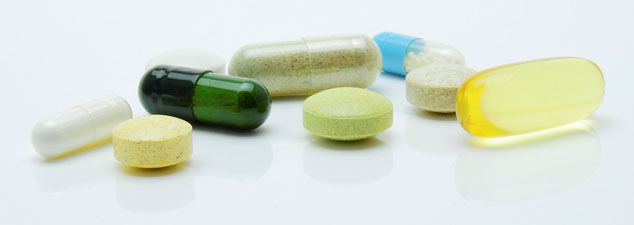 According to Claire Morton, senior industry analyst at New Hope, more customers are looking for experiential benefits from herbal supplements than ever before. (Nutraceuticals World, July/August 2023.) [Read more…]
According to Claire Morton, senior industry analyst at New Hope, more customers are looking for experiential benefits from herbal supplements than ever before. (Nutraceuticals World, July/August 2023.) [Read more…]
Correct Botanical Names = Supplement Integrity
 Yes, of course, Ginkgo biloba is the correct spelling of the scientific name for the Maidenhair Tree. [Read more…]
Yes, of course, Ginkgo biloba is the correct spelling of the scientific name for the Maidenhair Tree. [Read more…]
Why Bioavailability? A Supplement Marketing Trend On the Rise
 Q: What do the following have in common? Curcumin, quercetin, berberine, resveratrol, anthocyanins, and EGCG?
Q: What do the following have in common? Curcumin, quercetin, berberine, resveratrol, anthocyanins, and EGCG?
A: Low bioavailability.
They represent a growing list of natural products attracting scientific attention to improving their effectiveness as nutrients.
At the moment, a search on PubMed for “bioavailability” yields more than 130,000 articles. Adding “supplements” to the search carves out 4,800 of them. Substituting “nutraceuticals” lists more than 3,200.
And more than 99% of them appeared since the turn of the 21st century.
The bioavailability “hot” list above leads the way. Searches reveal the following numbers of articles:
2,200 on curcumin
1,000 on quercetin
265 on berberine
928 on resveratrol
506 on anthocyanins
309 on EGCG
They augment an impressive number of bioavailability studies on essential nutrients, including 5,289 on vitamins and 5,683 on minerals.
It’s no longer acceptable to advise supplement users to merely take a supplement with food, or on an empty stomach, or with certain other ingredients.
Nope. The name of the game is now all about efficiency of formulations – i.e., their bioavailability.
SAVVY CUSTOMERS ARE CATCHING ON
The top nutrient, curcumin, is a good example of how bioavailability can draw in more end users.
No wonder.
According to Grand View Research, the curcumin market size was valued at more than $58 million in 2020, with an expected CAGR of 16.1% from 2020 to 2028.
Social proof from customers using bioavailability-improved formulations lead this marketing tsunami.
“MY ARTHRITIS WAS GONE IN 3 DAYS!”
As much as market size numbers light up a marketing director’s eyes, they’re just sterile numbers.
What’s important to customers is how well a product works for them.
They care about their health, not marketing statistics.
Just taking a peek at customer experiences in reducing the pain and inflammation of arthritis emphasizes that point.
Mary’s story is typical.
“I was simply shocked with my results. I did a bit of research and found that [an enhanced bioavailability formulation] was necessary for proper absorption. I started taking 2 capsules daily. Within four days I started feeling much more freedom in my joints and could tell my inflammation had gone down significantly.
After a little more than a week I noticed my shoulders regained full range of motion, my knees and ankles can carry me through the whole round of golf, but that’s not all! I was having to keep a stroke counter on me to keep up with my score but after taking [the product] for 3 weeks, I could tell that I was thinking more clearly and the stroke counter was no longer needed. My brain functioning was sharper! A super side effect that was not expected!”
Ricky’s experience is even more remarkable:
“I’ve had over thirty corrective surgeries from the time of 9 months to 16 years old, just so I could walk normally.
I am now 58 years old and have severe arthritis in both knees, legs, feet and to top it off, I have golfers elbow in my left arm from playing bad golf for over 25 years. I bought your product as a last resort because the, “over the counter stuff” never worked for me. After just 3 days of taking [an enhanced bioavailability formulation], the pain in my knees went away! After 5 days, the pain in my legs, feet, and elbow went away! This is a God send!”
That kind of social proof is pure marketing gold.
Arthritis is just one example of health benefits customers rave about.
And they’re all driven by enhanced bioavailability formulations.
Curcumin is just one of several good examples.
Many other natural products aren’t too far behind.
A CHEMIST’S PERSPECTIVE
As a career natural products researcher, I’m thrilled to see my favorite plant substances taking center stage for alternative health.
It has been a long time coming.
The benefits of medicinal flavonoids, for example, were initially established in the late 1930s. They led one of the premier scientists at that time, Dr. Albert Szent-Györgyi, to even refer to them as “vitamin P.”
Starting in the 1950s, entire books began appearing about them, mostly out of leading labs in Hungary. This body of knowledge now forms the foundation for the recent emergent work directed toward improving their bioavailability.
Similar trends characterize the other substances on the hot list cited above, plus many others.
It pleases me to no end to see these developments. Ditto for my circle of fellow natural products chemists.
ESTABLISHING BRAGGING RIGHTS
Although ‘bragging’ may seem crass, that’s what claims about improved bioavailability must do for the bottom line.
It’s what distinguishes the better products from the rest.
If you’ve got it, flaunt it.
The question then becomes, how to do that most effectively.
IT’S AN EDUCATION PROCESS, WITH A TWIST
Start with a product already demonstrated to have improved bioavailability.
Once it’s in hand, main three strategies drive marketing outcomes.
These are what the leading manufacturers are doing now.
- Create targeted educational materials. For B2B companies, they start with white papers directed at decision makers who are responsible for selecting products for incorporation into retail formulations. Even though white papers may seem straightforward and factual, the twist is adding the right amount of persuasion copy without being salesy.
- Provide ‘bragging’ support for retailers. B2C companies are probably not going to conduct research on the ingredients they use. This is the role of the B2B supplier. Research lays the foundation for generating marketing copy the retailer can employ for attracting and retaining customers. In other words, the gems retailers rely on for advertising, product pages, email campaigns, magalogs, and even ebooks.
- Got a consulting scientist? A scientist who can explain the ins and outs of product research to B2C marketers is worth his or her weight in gold. Someone with a PhD in natural products chemistry and a strong background in education is ideal. Having one on staff would be the top choice if the budget allows. Having one on retainer would be even more cost-effective.
Although these might seem to be sweeping strategies, many manufacturers are already following them to some extent.
Going back to the curcumin example, at least a dozen B2B suppliers have branded products for use by retailers. They’re all supported by solid research showing improved bioavailability.
How solid?
Their research appears in peer-reviewed scientific journals. It doesn’t get any better than that for scientific validation.
TAKING THE NEXT STEP
No matter where your company is among the three strategies listed above, you might benefit from the efforts of a scientist-writer-educator for creating your marketing materials.
I’ll get right to the point: that’s exactly what I am.
A 30-year professor at a major research university. Dozens of publications in scientific journals. Co-author of a best-selling university-level textbook. A specialist in natural products chemistry. An experienced writer for B2B and B2C supplement companies.
If you see your company needing the services of someone like that, please feel free to contact me to we can talk about how I can help you.
Messaging via my contact form here works: Contact.
So does direct email (drdennisclark@gmail.com).
If you’re feeling really wild, give me an actual call at the number on the top of this page.
Leave a message and I’ll get back to you ASAP.
Go ahead and give me a buzz to get our conversation started today.
All the best in natural health,
Marketing Postbiotics? How to Meet New Challenges
 The market for postbiotics is hot and getting hotter. According to the Global Postbiotics Market report by Prophecy Market Insights, it already accounted for $40.51 billion in 2020 and is expected to reach $83.30 billion by 2030, at a CAGR of 7.50%.
The market for postbiotics is hot and getting hotter. According to the Global Postbiotics Market report by Prophecy Market Insights, it already accounted for $40.51 billion in 2020 and is expected to reach $83.30 billion by 2030, at a CAGR of 7.50%.
Since the numbers are that good, what are the challenges?
They include the usual suspects for all marketing – generating traffic and leads, raising ROI, managing a multi-pronged online presence, reaching global audiences, etc.
The ‘bonus’ challenge is the topic of postbiotics itself.
Why is that a challenge?
The following should shed some light on it.
AN UNSCIENTIFIC SURVEY
My Survey Question: What do you know about postbiotics?
Everyone’s Answer: Never heard of ‘em.
This is a consistent result across all consumer segments. (Meaning: friends, relatives, colleagues, etc., who already take supplements.)
On one hand, plenty of people are savvy about vitamins, minerals, herbs, and antioxidants.
In addition, probiotic-buying consumers have even caught onto the importance of prebiotics.
Yet, on the other hand, confusion seems to reign when it comes to postbiotics.
One indicator is the plethora of online articles addressing the question, What are postbiotics?
In other words, in spite of a successful and promising market, the topic of postbiotics is at the bottom of a learning curve for consumers.
Nevertheless, a few leading companies are doing something right. Their efforts are driving market growth.
And that ‘something’ includes a strong educational component.
Furthermore, the best of them already have a stable of clinical trial studies supporting their efforts. LBiome, for example, cites dozens of journal articles, going back to 2004.
AN ADMISSION
Although I’ve written and consulted quite a bit about probiotics – books, articles, magalogs, emails – I’ve never before used the term ‘postbiotics’.
Not one of my clients has ever mentioned them. And I’m talking about some very successful probiotic businesses.
IS SOMETHING MISSING?
Yes.
Supplement marketing rests on much more than an educational component.
People don’t respond to a ‘BUY NOW’ call-to-action because of the scientific features backing a product.
No, buying action is driven by emotion. And that’s where extolling the health benefits of a supplement through persuasive copy comes in.
Of all the ‘marketing’ I’ve evaluated about postbiotics, the biggest missing component.
One segment has done a pretty good job addressing it – the bodybuilding market. It’s pretty straightforward to talk to the ‘I want to look like I’m cut out of stone’ crowd. Postbiotics fit the bill nicely for pushing muscle-building hot buttons.
The time is ripe for more benefits-heavy marketing to other market segments.
Gut health is the obvious emphasis, since it’s already at the core for marketing probiotics and prebiotics. So it’s no surprise, according to Lumina Intelligence, postbiotics have become the fastest growing area in terms of gut health related Google searches – a whopping 1,300% increase in the past 2 years.
However, as of 2020, the supplement buying public has grown more interested in immune support than in any other area of health.
Postbiotics fit the bill there, too. A few companies have begun to talk about postbiotics for immune health. However, their marketing copy is routinely staid and feature-based.
It’s a marketing gap crying out for persuasive copy.
If I were a betting man, I’d bet the predicted market growth of $83.30 billion by 2030 would be reached sooner when driven by truly persuasive marketing. And it would blow the doors off that CAGR of 7.50% cited earlier.
SIMPLE ACTION STEPS
No need to make this complicated. The model for marketing supplements has been well-established for more than a century.
The foundation is knowing what people want or need, then providing it. Regarding postbiotics, that’s primarily going to be better gut and immune health.
Then get the word out…
- Create new marketing materials, or modify existing ones, to emphasize benefits. That’s the high-performance fuel for a marketing Ferrari.
- Harness the marketing power of your customer base. User-generated content (UGC) drives two of Dr. Robert Cialdini’s principles of persuasion – social proof and unity. Although this may seem easier said than done, you can simplify the process with a few easy-to-use strategies (e.g., see my earlier article: How to Improve Supplement Sales with User-Generated Content).
- For B2B companies, a good white paper goes a long way. Emphasis is on ‘good’ – i.e., pushing different kinds of hot buttons for retail marketing people who might be considering using your ingredients. For B2C companies, selecting a top manufacturer is the most important starting point. This means more than having good products. It also means having access to persuasive marketing copy from the manufacturer. (At the moment, that copy is going to be hard to find.)
These three steps represent three prongs of a comprehensive program for marketing postbiotics. They will take some time. Nevertheless, they will be worth it to the bottom line.
Now imagine combining your best scientist and your best marketer into one person. Then add in superior copywriting skills.
That’s a very rare combination, wouldn’t you say?
THE ALL-IN-ONE PUNCH
I am that combination.
My career as a research scientist, published author, and freelance copywriter is a testament to it.
I understand the jargon of scientific studies and can translate it into marketing content that drives supplement sales. I’ve already written a books, articles, and white papers on the microbiome.
It’s one of my favorite topics in alternative health.
Would you like to explore what I can do for you? Then let’s talk.
Contact me today.
Contact me directly by email me at drdennisclark@gmail.com, reach me the old-fashioned way – by phone (602-908-8520), or complete my contact form.
I’d love to chat with you to see how we can work together to build strategies for marketing your postbiotic products.
All the best in natural health,
How to Market Flavonoids – Persuasive Content Meets Bioavailability Research
 The flavonoid market is huge and growing fast. Mordor Intelligence forecasts it to reach USD 1.2 billion by 2024. Sales are increasing at a CAGR of 3.9%.
The flavonoid market is huge and growing fast. Mordor Intelligence forecasts it to reach USD 1.2 billion by 2024. Sales are increasing at a CAGR of 3.9%.
One molecule stands out from about 6,000 known flavonoids.
Quercetin.
It’s a model for flavonoid marketing, with one caveat – its low bioavailability.
Solving this issue with quercetin is marketing gold for flavonoids. [Read more…]
How to Boost Nutraceutical Landing Page Conversions by 100%
 Q: What’s the most indispensable marketing tool on the entire internet?
Q: What’s the most indispensable marketing tool on the entire internet?
A: Good landing pages.
Indeed, landing pages are the engines driving all marketing campaigns. Or at least they should be. [Read more…]
Pet CBD Marketing: How To Stand Out From The Crowd
 Pets are driving astounding growth in the CBD market. Grandview Research predicts a 40.3% CAGR in this market segment from 2020 to 2027.
Pets are driving astounding growth in the CBD market. Grandview Research predicts a 40.3% CAGR in this market segment from 2020 to 2027.
The data are sufficiently tantalizing that just about every CBD company has jumped in.
Thousands of them.
However, marketing efforts by the vast majority revolve simplistically around, “Oh, we’ve got pet stuff, too.”
In contrast, industry leaders for pet CBD marketing have figured out how to rise above the fray. [Read more…]
Compassion And Hope: The Beating Heart Of Great CBD Companies
 How do you compete against a soaring number of other CBD companies?
How do you compete against a soaring number of other CBD companies?
A great way for finding an answer to that question is to examine how top companies succeed.
Sure, they all do the mundane things well – SEO, email marketing, advertising, social media, etc.
More importantly, what do they do to rise above the marketing fray? [Read more…]
Supplement Marketing with Ebooks: How to Whip the Competition Now
 Ebooks are a gold mine for supplement marketing.
Ebooks are a gold mine for supplement marketing.
Why?
According to SEO guru Neil Patel, ebooks have the power to massively and quickly improve your marketing ability.
And their impact can be multiplied by spinning them off into blog posts, email series, free reports, ads, social media entries, and magalogs – without writing another word! [Read more…]
Anti-Aging Supplements – Making the Most of Extraordinary Market Growth
 The global anti-aging market was $52.5 billion in 2020. Surveys at Statista.com predict this segment’s growth to reach $83.2 billion by 2027.
The global anti-aging market was $52.5 billion in 2020. Surveys at Statista.com predict this segment’s growth to reach $83.2 billion by 2027.
That’s just part of the good news.
Even better news is the phenomenal success some supplement companies are having in this market segment. [Read more…]
How to Improve Supplement Sales with User-Generated Content
 How did one particular supplement business skyrocket sales by 181% over a recent 5-year period?
How did one particular supplement business skyrocket sales by 181% over a recent 5-year period?
Such success means they’ve done a lot of things right. However, one particular strategy stands out: user-generated content (UGC) marketing. [Read more…]
Pet Supplement Marketing: Want to Learn How to Make Your Message Howl?
 One powerful strategy can make your products really stand out from a crowded pet supplement market. And few companies are using it, in spite of market surveys pointing directly to its value.
One powerful strategy can make your products really stand out from a crowded pet supplement market. And few companies are using it, in spite of market surveys pointing directly to its value.
Indeed, it hits the sweetest of marketing sweet spots for the target audience – pet owners. [Read more…]
One Segment of the Probiotics Market Catapults Sales Faster Than All Others
 Growth in the probiotics market over the past 5 years has hovered around 50%.
Growth in the probiotics market over the past 5 years has hovered around 50%.
One market segment has become a rising star behind this trend.
It’s the weight management segment. [Read more…]
The Nutraceutical Marketing Gold Rush – Or How To Find Happy Customers for Life
 The well-known 80/20 rule works even better for nutraceutical companies.
The well-known 80/20 rule works even better for nutraceutical companies.
It’s more like 90/10.
No, kidding. The mother lode of profits – 90%! – comes from the golden 10% of customers. [Read more…]
Powerful Advantages of Outsourcing Marketing Copy for Nutraceuticals
 Companies putting out 16 or more blog posts per month get three times the amount of traffic compared with those publishing only one or two. [Read more…]
Companies putting out 16 or more blog posts per month get three times the amount of traffic compared with those publishing only one or two. [Read more…]
How to Turn Pets Into An Irresistibly Lovable Marketing Department
 Pets are a ‘secret sauce’ for nutraceutical marketing.
Pets are a ‘secret sauce’ for nutraceutical marketing.
Unleashing their power for driving up revenue works regardless of whether you’re marketing pet products. It works no matter what you’re selling.
Even better, using pet power the right way boosts sales in spite of market dominance by big retailers. [Read more…]
How to Hit Your Target Market Bullseye Every Time
 According to a recent HubSpot review, one particular marketing strategy can boost your ROI by as much as 760%.
According to a recent HubSpot review, one particular marketing strategy can boost your ROI by as much as 760%.
Yet many supplement companies either don’t do it or they don’t do it very well.
This article talks about a strategy I discovered for my own marketing plan. It also outlines how you can use it, too. [Read more…]
How to Boost Nutraceutical Sales Using This One Simple Thing
 Nutraceutical marketing isn’t easy these days. It screams for constant attention and can be a real drain on your time and budget. [Read more…]
Nutraceutical marketing isn’t easy these days. It screams for constant attention and can be a real drain on your time and budget. [Read more…]
Frustrated with Email Marketing? Take Heart
 Are you beginning to doubt the value of email marketing? Open rates are down. Click-throughs are disappearing. Conversion rates are submicroscopic. Revenue is suffering. [Read more…]
Are you beginning to doubt the value of email marketing? Open rates are down. Click-throughs are disappearing. Conversion rates are submicroscopic. Revenue is suffering. [Read more…]
Excellent Example Of Health Copywriting By Dr. Al Sears: “CoQ10’s Failure Leaves Millions Wanting”
 A recent ad from Dr. Al Sears exemplifies good health copywriting. It represents a template for hard copy ads and landing pages. However, although it can be a model for nutraceutical marketing, a few changes would make it even better. [Read more…]
A recent ad from Dr. Al Sears exemplifies good health copywriting. It represents a template for hard copy ads and landing pages. However, although it can be a model for nutraceutical marketing, a few changes would make it even better. [Read more…]